One of the many joys of fieldwork is the fact you have no idea what each day might bring. Apart from the main focus of your work delivering up constant surprises, the environment you are working in is often as fascinating and throws up seemingly endless delights. If you are digging in a foreign country, then this effect seems magnified and everything around you becomes a vital part of the experience. The very nature of fieldwork means you are getting up close and personal to the land and the flora and fauna you share it with for the duration of the trip. On top of all this, there seems to be a sense of heightened awareness: in the rock you are working, the weather, the lay of the land, the sounds. . . . well, you understand. The context of the physical and mental activity that is fieldwork.
So here is the first of three posts that deal not with the fieldwork itself, but the incidental finds that over the years have attracted my attention. These may seem mundane or irrelevant and of course scientifically they are, but these finds are as much a part of the field experience as the fossils we strive to discover and understand.
 |
Three articulated vertebra, bleached by the sun.
No idea what they belonged too, but I'm guessing artiodactyl.
Hell Creek Formation, South Dakota, USA. |
 |
The wreck of The Carbon. Compton Bay, Isle of Wight, UK.
You need a low tide to get this close too the old metal-hulled boat, which came to grief on the rocks of the Wessex Formation, Wealden. She was a 175-ton steam tug that was under tow in November 1947 when she came loose and ran aground. |
 |
Deer leg. We saw Mule deer in the area of our quarry, but this also might be a Whitetail
or Pronghorn, both of which live on the prairie and badlands. Hell Creek Formation, South Dakota, USA. |
 |
Upper jaw fragment. Once more, I have no idea what this is from, but I'll go with artiodactyl as a guess.
Potter Canyon, Dinosaur Canyon Member, Moenave Formation, Arizona, USA. |
 |
Native American microlith. In the UK, this would come home but there are understandably
very strict laws regarding the removal of Native American artifacts, so it stayed in-situ.
Moccasin Mountain, Navajo Sandstone Formation, Utah, USA. |
 |
Petroglyphs, Fort Pierce, Utah, USA. These superb petroglyphs are carved into the desert varnish
on outcrops of Shinarump Member of the Chinle Formation.
We also heard a very loud boom at this point, possible sonic, mine or other blasting.
As for what these petroglyphs actually depict, there is plenty of debate and interpretations vary. |
Where possible, I always bring incidental finds home as they act as not only objects of interest in themselves but reminders of a moment in time, which often have very happy memories. Antlers, skulls, sea glass, various sub-fossil bones, teeth, hagstones, feathers, shells minerals and one day a rather fine geological hammer all enter the collection and each has a memory attached. Wonderful.
Next: Critters

